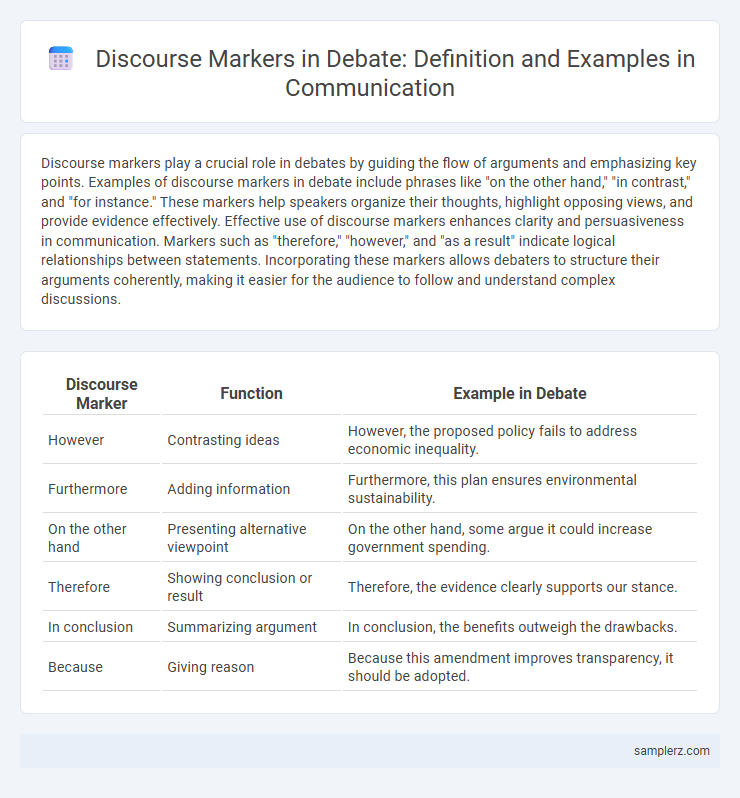Discourse markers play a crucial role in debates by guiding the flow of arguments and emphasizing key points. Examples of discourse markers in debate include phrases like "on the other hand," "in contrast," and "for instance." These markers help speakers organize their thoughts, highlight opposing views, and provide evidence effectively. Effective use of discourse markers enhances clarity and persuasiveness in communication. Markers such as "therefore," "however," and "as a result" indicate logical relationships between statements. Incorporating these markers allows debaters to structure their arguments coherently, making it easier for the audience to follow and understand complex discussions.
Table of Comparison
| Discourse Marker | Function | Example in Debate |
|---|---|---|
| However | Contrasting ideas | However, the proposed policy fails to address economic inequality. |
| Furthermore | Adding information | Furthermore, this plan ensures environmental sustainability. |
| On the other hand | Presenting alternative viewpoint | On the other hand, some argue it could increase government spending. |
| Therefore | Showing conclusion or result | Therefore, the evidence clearly supports our stance. |
| In conclusion | Summarizing argument | In conclusion, the benefits outweigh the drawbacks. |
| Because | Giving reason | Because this amendment improves transparency, it should be adopted. |
Introduction to Discourse Markers in Debate
Discourse markers such as "Firstly," "In my opinion," and "To illustrate" play a crucial role in structuring arguments during debates. These markers help signal the introduction of new points, clarify perspectives, and organize the flow of ideas, enhancing audience comprehension. Mastery of discourse markers improves coherence and persuasiveness in formal debate settings.
Importance of Discourse Markers for Effective Communication
Discourse markers such as "however," "therefore," and "on the other hand" play a crucial role in debates by clearly signaling shifts in arguments and enhancing the logical flow between points. These markers help listeners track the speaker's reasoning, improving comprehension and engagement. Effective use of discourse markers supports clarity, coherence, and persuasive communication in competitive discussions.
Types of Discourse Markers Used in Debates
In debates, common types of discourse markers include contrast markers like "however" and "on the other hand" to introduce opposing arguments, addition markers such as "furthermore" and "moreover" to strengthen points, and conclusion markers like "therefore" and "in conclusion" to summarize positions. Temporal markers, for example "firstly" and "finally," help organize arguments chronologically, while clarification markers such as "in other words" assist in rephrasing for better understanding. These discourse markers enhance the clarity, coherence, and persuasive power of a debater's communication.
Discourse Markers for Introducing Arguments
Discourse markers like "firstly," "to begin with," and "in the first place" play a crucial role in structuring arguments during debates. These markers help signal the introduction of key points, making the speaker's reasoning clearer and more persuasive. Effective use of such markers enhances coherence and guides the audience through the logical progression of the argument.
Examples of Discourse Markers for Contrasting Ideas
Discourse markers such as "however," "on the other hand," and "in contrast" effectively signal opposing viewpoints in debates. These markers clarify shifts between contrasting ideas, enhancing the coherence and persuasiveness of arguments. Utilizing phrases like "nevertheless" and "whereas" further emphasizes differences and strengthens the debate's analytical depth.
Signaling Agreement and Disagreement in Debate
In debates, discourse markers such as "I agree" and "That's a valid point" effectively signal agreement, fostering constructive dialogue. Conversely, phrases like "I respectfully disagree" and "On the other hand" clearly indicate disagreement while maintaining politeness. These markers play a crucial role in managing interpersonal dynamics and clarifying positions throughout the discussion.
Discourse Markers for Summarizing Points
Discourse markers like "in summary," "to conclude," and "overall" effectively signal the summarization of key arguments during a debate. These markers help clarify the speaker's main points, ensuring coherence and aiding audience comprehension. Employing such markers enhances the persuasiveness and clarity of oral communication by highlighting the central ideas succinctly.
Expressing Causality and Consequence with Markers
In debates, discourse markers such as "therefore," "consequently," and "as a result" effectively express causality and consequence, clarifying the logical relationship between arguments. These markers guide listeners in understanding how one point leads to another, reinforcing the speaker's reasoning. Using precise causative markers enhances the coherence and persuasiveness of debate communication.
Transitioning Between Arguments Using Discourse Markers
Discourse markers such as "on the other hand," "furthermore," and "in contrast" facilitate smooth transitioning between arguments in debates by signaling shifts in perspective or emphasis. These markers help maintain the flow of discussion, allowing speakers to clearly differentiate and connect opposing or supporting points. Effective use of discourse markers enhances clarity and persuasiveness in communication during debates.
Enhancing Persuasion with Effective Discourse Markers
Discourse markers such as "for instance," "in other words," and "on the contrary" play a pivotal role in debates by clarifying arguments and reinforcing points. These phrases guide the audience through complex reasoning, making ideas more accessible and compelling. Strategic use of discourse markers enhances persuasion by structuring speech logically and emphasizing key evidence.

example of discourse marker in debate Infographic
 samplerz.com
samplerz.com